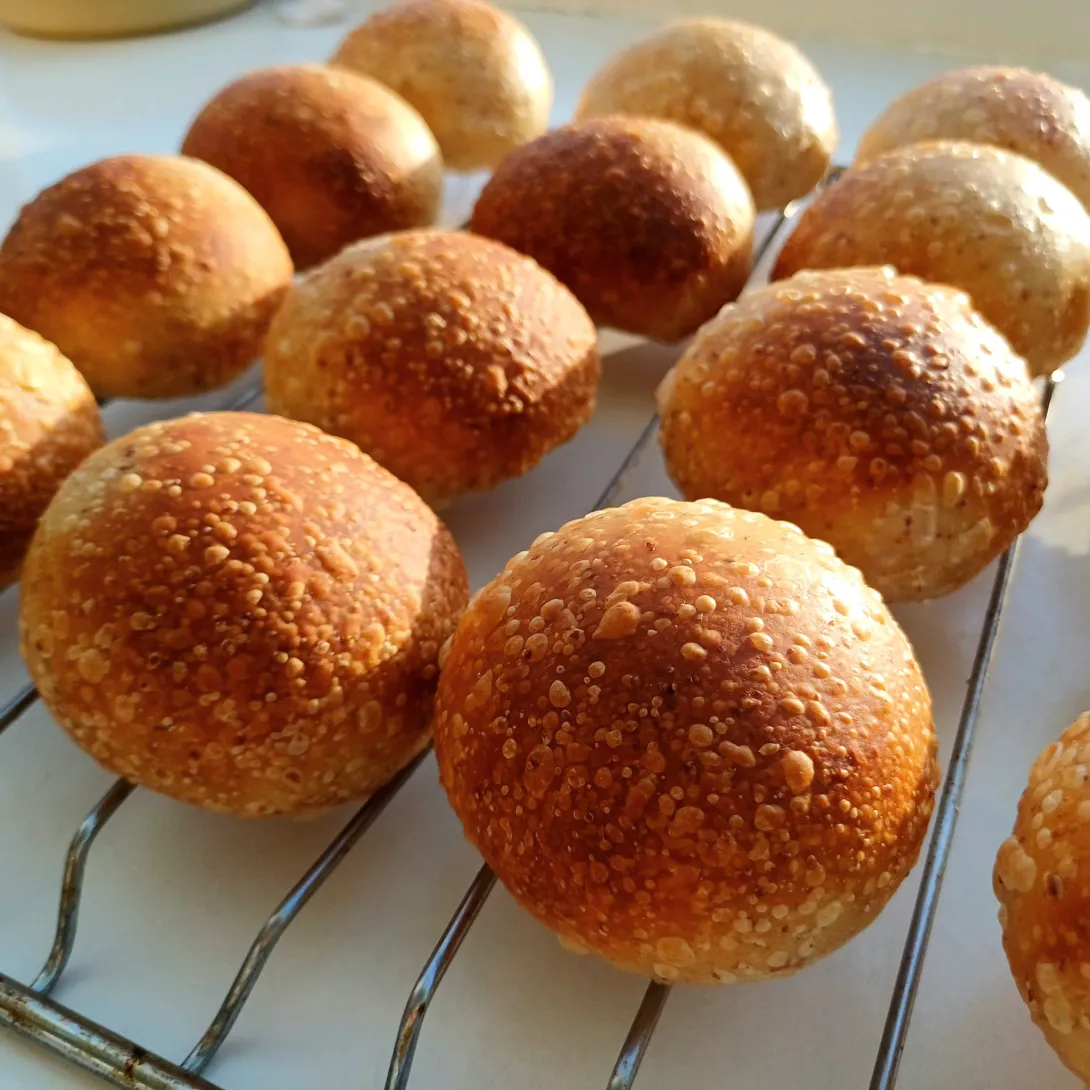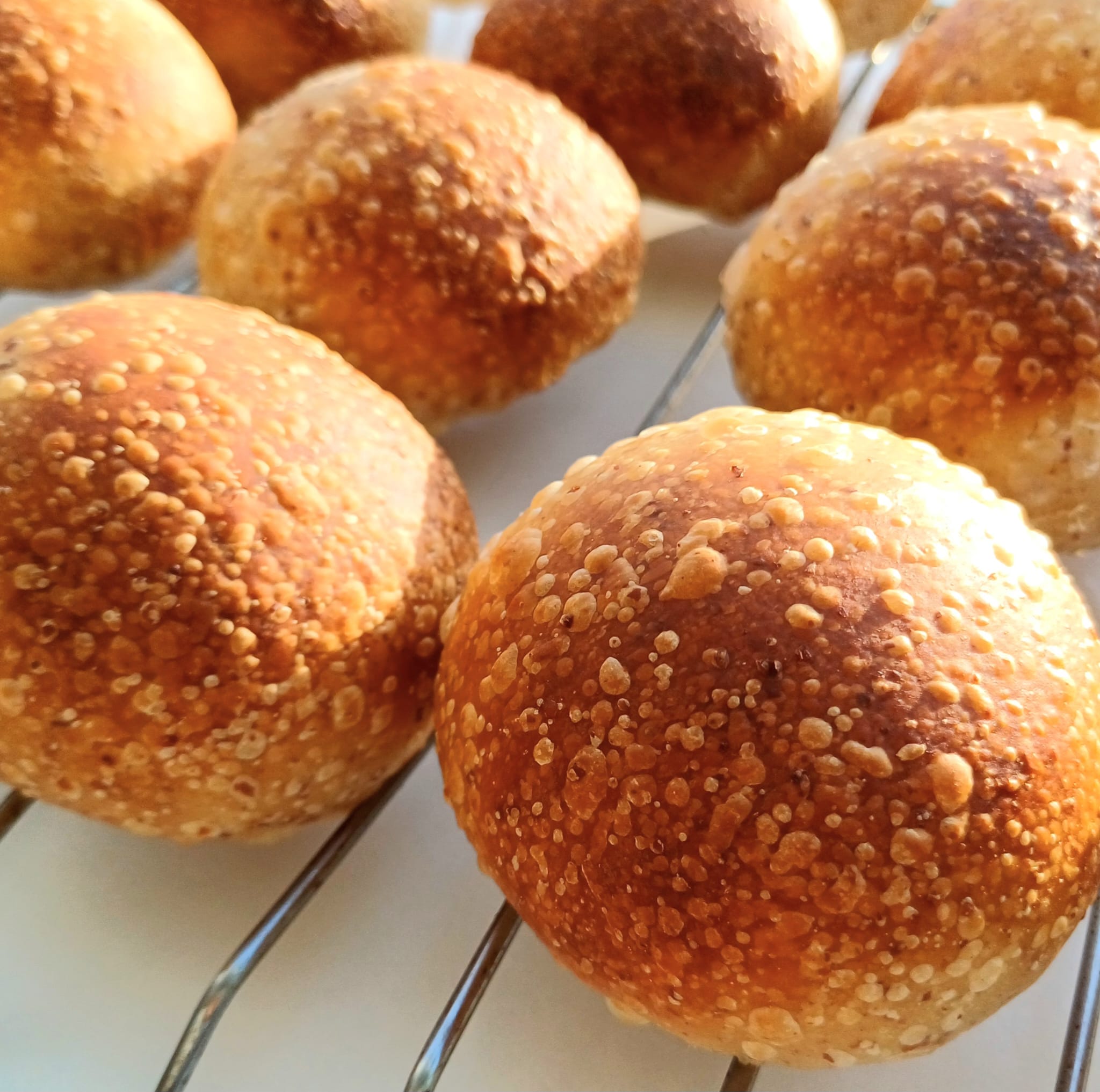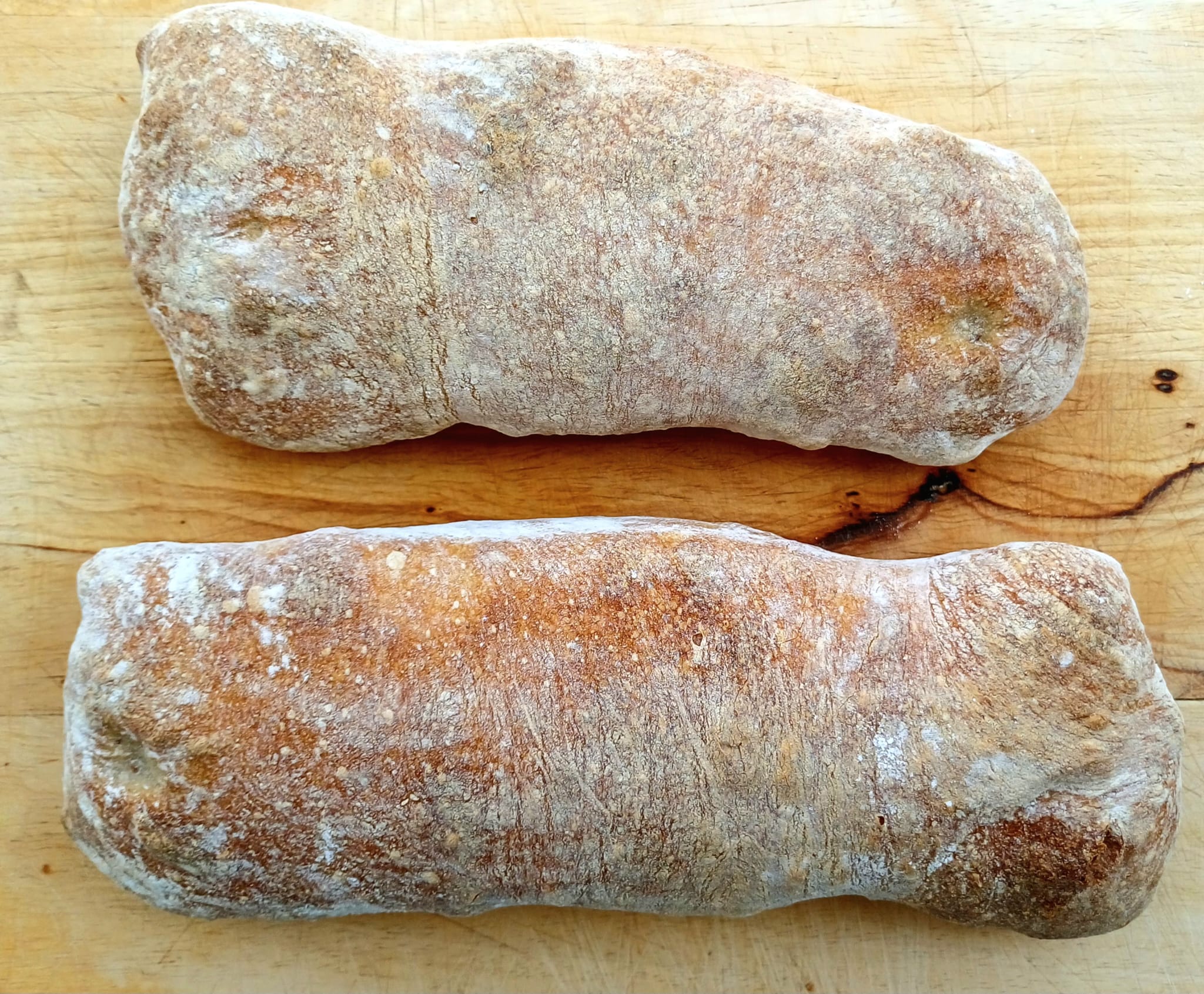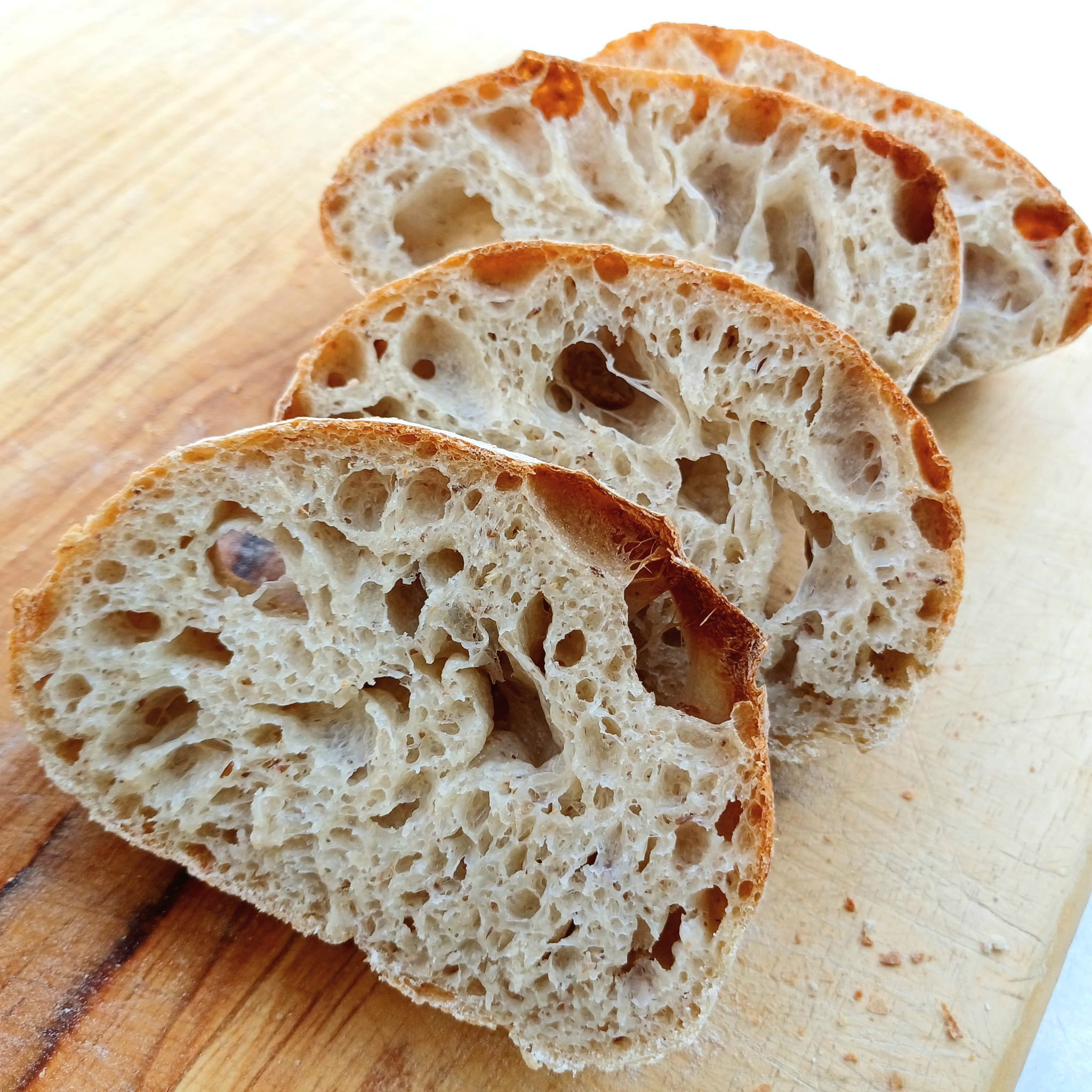
Two functional bakes to fit into the routine and needs of the family.
The first are IDY soft rolls that are baked in the morning and ready to eat in 30 mins from the moment the oven is switched on. It's a standard 75% white dough with 25% wholegrain (usually wheat, khorasan or spelt) in a tangzhong, mixed with milk, 1 tablespoon of honey, 1 tablespoon of olive oil and a minute pinch of IDY. I make the dough in the evening, give it a really good and vigorous hand knead, let it rest for about 40 mins, then shape them on the baking tray and leave them covered at room temperature (now 20 degrees). The next morning they would have doubled. I bake them at 175 degrees for 18 mins. These buns are very soft and tasty from the overnight fermentation; the kids eat them without anything on it. And they always have incredible blisters!

The second is a sourdough ciabatta that is mixed in the morning and ready to be baked for lunch at noon. Essentially it's a 80% biga formula; this ciabatta was 70% white bread flour with 20% khorasan and 10% wholewheat.

The 45% hydration biga was made 14 hours before mixing the final dough; the next morning it was soaked in water for 10 mins making up to around 85% hydration, before the remaining 20% white bread flour and salt were added. The dough came together very quickly. I bulked it for 2 hours, proofed for 1.5, and baked for 25 mins. Smaller ciabattas mean they bake and cool fast so we eat them fresh and slightly warm. Very nice and soft crumb.

Sadly there isn't a lot of time recently to experiment a lot, but such functional bakes still keep me happy while ensuring everyone gets to eat fresh bread without fuss.
- ll433's Blog
- Log in or register to post comments
amen! 😆
beautiful bakes, Lin! And in conjunction to all points you made, I think we all should have in our repertoire recipes for daily rotation, and recipes to entertain/ for gifting purpose
Jay
Just that I appear to have been on daily rotation for ages now :D Am looking forward to baking something a bit more special soon.
Both the rolls and the ciabatta look absolutely the best. Wow!
TomP
Appreciate it, very kind of you.
Both bakes look very very good! An the blisters 🤩
We always have some constraints. Sometimes they allow only for "effortless" unsophisticated formulas.
Yes, the blisters - the kids call them "bubble buns" ;)
'Function is the key!' Those are some beautiful breads. -- Rob
there I was wondering.. what ref is this now?? Did give the Fugazi a listen this morning just in case ... 🤔
you got it!!!👏🏼👏🏼👏🏼👏🏼 My alt-interpretation is that that song is about bread-baking.
Oh Lin these are marvelous! And convenient too, in terms of time scheduling.
How big are the rolls? It looks like you made more than a dozen of them!
Also think you may have solved how to get that crackly crust on the "courage bagels" that I've been trying to get. A pinch of yeast is how much for you, do you have a scale that is capable of weighing that pinch for me? Thanks!
-Jon
The conclusion is that it's around 0.5g of yeast. My scale is only capable of weighing up to 1g, so I made sure that 1 teaspoon is indeed 3g - confirmed - and that 1/3 of that is 1g - check - and I only use half of that for 500g of flour. I tend to mix the dough at around 8pm, all shaped by 9pm, and baked at 7 am, so that's about 11 hours.
The rolls are quite small. I make about 14 rolls with 500g of flour - that always works well to get everyone filled for breakfast and enough for the kids to pack to school.
I have not been following the courage bagels thread - let me catch up on it! I'm always so intrigued by the super blisters that form on these buns - something that I used to associate with loaves left to proof in the fridge. I suppose it's quite simply a result of a prolonged period of proofing? That the bubbles completely rise to the surface or something like that? After all, these buns aren't actually bulked. The 40 mins rest after extensive kneading is simply meant to get them relaxed enough for shaping.
I especially like those rolls, Lin; I'm always on the hunt for the perfect yeasted roll recipe - and this one looks good!
What was your total flour weight for the honey and olive oil quantities specified?
Lance
I tend to use only 500g of flour for 14 rolls, with 125g of that in the tangzhong. I know that the honey and olive oil sound pretty meagre for these quantities, but the wholegrain tangzhong and long fermentation do give lots of flavour. Plus fresh bread out of the oven really needs very little enhancement.
Nice bakes and a very clever process. The way that the biga is soaked before mixing solves an issue I have had with incorporating it into the dough. The overnight proofed on the counter rolls are an ingenious use of a pinch of yeast. Thanks for sharing.
Don
Very kind of you to say. The biga soaking really cuts a lot of time - even better if the water is just slightly warm.
These look fantastic!
Best,
Ian
Appreciate it.
Your bakes never fail to impress Lin. The ciabatta looks perfect. Maybe just a tiny bit flatter in shape, but wow!
You've taken on the mantle if the crumble biga champion! Lovely to see what good use you are making of the technique.
Just wondering about your oven settings. Guessing no DO involved in these. Did you use any steam? Settings? That kind of thing.
I love how you take even simple breads and make them special with some technical twist or tweak and are always looking to experiment and improve those as you go along.
And thanks for being so encouraging. The dry biga method that you shared with me has really reaped lots of rewards. I just find it such a convenient, fast and powerful method. It really is my go-to now.
Oven settings - I baked the ciabatta with some steam at 220 degrees on a preheated oven tray. As for the buns, they are usually loaded into the oven the moment it's done pre-heating (7 mins to get to 175 degrees). Those are baked without steam.
Hope you've been well and still baking lots of durum wheat loaves!
Ah, finished my two packs of rimacinata i had from Italy a long time ago!!! Not really a flour one funds regularly in the UK. Use pasta flour which usually has some durum in it if I'm really desperate, but been working on some stable baseline 30% whole groan loaves lately that are as close to white loaves in terms of crumb, texture, crust crunch as possible. Not quite there yet so nothing much to report.
Lin, I asked AI about creating blisters and it said several things: long, slow, cold ferment, hot oven, steam/spraying, and no flour on the surface were the main ones. But, I said, she did none of that except for long, WARM ferment. Good enough, said AI (I love these chatbots, but you've got to keep on top of them). It's the long ferment, as you suggested. It causes a breakdown of gluten and acidification near the surface. That thins the crust and allows the gas to penetrate the surface. Those blisters are amazing on a recipe where you wouldn't expect them!
When measuring tenths of a gram on the scale, it will do it if it already has some weight registered. So, a bit of flour/whatever in the bowl, then add 1/10s of a gram of yeast. Since the scale reads in tenths after it gets above a minimum weight, that should work.
Most digital kitchen scales I've seen only display on the half-gram. That is, 0.5, 1.0, 1.5, ... If the scale were perfect it would change from .5 to .0 or .0 to .5 when the weight got more than the halfway point between the two. But how reliable that is depends on the quality of the scale.
Even if the scale could read to tenths of a gram, a given reading would only be precise to half of that at best. The error could be nearly 50%.
You could measure 1g yeast and 99g flour, mix them together thoroughly, and then measure 10g of the mixture. That will be closer to an actual 1/10g than trying to fiddle between scale graduations. Save the rest for another bake.
TomP
I have an inexpensive Amazon Etekcity scale that measures in 1/10 grams. I put a bit of water in a bowl, then added drops from my fingers to see how it registered. It went from 2.9 to 3.0 to 3.2, so pretty accurate for baking purposes, I think. I believe when I was shopping for it I wanted fractions of a gram.
It depends on how precise you want to be. When I'm measuring 300g of flour I don't worry about hitting it to a gram or two. If I'm measuring 6g of salt for that flour I don't mind if I'm 1/2g off. You are measuring 0.1g with a scale precision of 0.1g. The measurement is likely to be 25 - 50% off, just because the readout can't be more precise. Does that matter?
And you're right, I did absolutely none of that! And when I do indeed do some of that for other loaves, blisters do not always appear. Not that blisters would change the taste, but they are just fun to have and it's nice to know how to get them.
A little tidbit of info: the loaf I baked yesterday got sprayed, but not uniformly. The side that got the direct spray had blisters, but the side away from the sprayer did not.
That doesn't matter, but I wanted to measure a pinch of yeast. I am making bread, so measured out 167.5 water and added a pinch of yeast. Funnily, the weight changed several times, without my touching anything, but started and ended at 167.8. So, it agreed with Lin's calc of .3g for a pinch. However, I used ADY not IDY and don't know if it was a "minute" pinch or a regular pinch. 😋
I don’t usually get blisters but I evidently don’t do the needed fermentation. The rolls look terrific as does that Ciabatta. I need to make some again haven’t done so in quite awhile.
Always enjoy your posts. c
Always nice to have you drop by. I've been following your pullman bakes closely too, and always appreciate the elegance and simplicity of your methods. I, too, prefer to let time do the work (usually when I'm sleeping).
Absolutely gorgeous Lin, especially the blisters on the rolls/buns and the open crumb of your ciabatta.
Benny